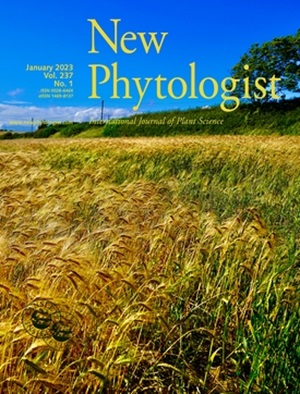Two antagonistic gene regulatory networks drive Arabidopsis root hair growth at low temperature linked to a low-nutrient environment
IF 8.3
1区 生物学
Q1 PLANT SCIENCES
引用次数: 0
Abstract
- Root hair (RH) cells can elongate to several hundred times their initial size, and are an ideal model system for investigating cell size control. Their development is influenced by both endogenous and external signals, which are combined to form an integrative response. Surprisingly, a low-temperature condition of 10°C causes increased RH growth in Arabidopsis and in several monocots, even when the development of the rest of the plant is halted.
- Previously, we demonstrated a strong correlation between RH growth response and a significant decrease in nutrient availability in the growth medium under low-temperature conditions. However, the molecular basis responsible for receiving and transmitting signals related to the availability of nutrients in the soil, and their relation to plant development, remain largely unknown.
- We have discovered two antagonic gene regulatory networks (GRNs) controlling RH early transcriptome responses to low temperature. One GNR enhances RH growth and it is commanded by the transcription factors (TFs) ROOT HAIR DEFECTIVE 6 (RHD6), HAIR DEFECTIVE 6-LIKE 2 and 4 (RSL2-RSL4) and a member of the homeodomain leucine zipper (HD-Zip I) group I 16 (AtHB16). On the other hand, a second GRN was identified as a negative regulator of RH growth at low temperature and it is composed by the trihelix TF GT2-LIKE1 (GTL1) and the associated DF1, a previously unidentified MYB-like TF (AT2G01060) and several members of HD-Zip I group (AtHB3, AtHB13, AtHB20, AtHB23).
- Functional analysis of both GRNs highlights a complex regulation of RH growth response to low temperature, and more importantly, these discoveries enhance our comprehension of how plants synchronize RH growth in response to variations in temperature at the cellular level.
求助全文
约1分钟内获得全文
求助全文
来源期刊

New Phytologist
生物-植物科学
自引率
5.30%
发文量
728
期刊介绍:
New Phytologist is an international electronic journal published 24 times a year. It is owned by the New Phytologist Foundation, a non-profit-making charitable organization dedicated to promoting plant science. The journal publishes excellent, novel, rigorous, and timely research and scholarship in plant science and its applications. The articles cover topics in five sections: Physiology & Development, Environment, Interaction, Evolution, and Transformative Plant Biotechnology. These sections encompass intracellular processes, global environmental change, and encourage cross-disciplinary approaches. The journal recognizes the use of techniques from molecular and cell biology, functional genomics, modeling, and system-based approaches in plant science. Abstracting and Indexing Information for New Phytologist includes Academic Search, AgBiotech News & Information, Agroforestry Abstracts, Biochemistry & Biophysics Citation Index, Botanical Pesticides, CAB Abstracts®, Environment Index, Global Health, and Plant Breeding Abstracts, and others.
 求助内容:
求助内容: 应助结果提醒方式:
应助结果提醒方式:


